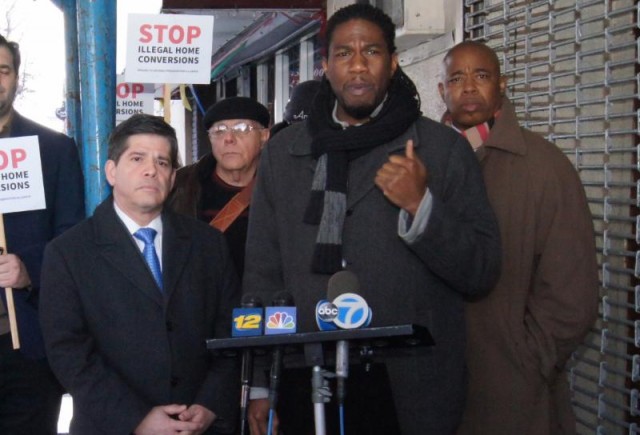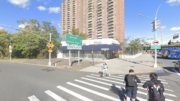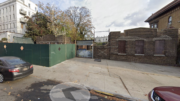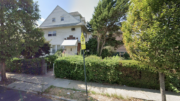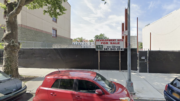As New York sprawled northward throughout Manhattan, the European immigrants flooding into the city were often housed in old single-family homes, crammed into a few rooms in buildings built for much smaller numbers of far wealthier people. Rows of brick townhouses and brownstones erected in Manhattan in the 19th century for the middle and upper classes would fall out of style and be carved up into tenements, packed with the city’s upwardly mobile immigrants.
Some of the descendants of those Italians who once lived in brownstone apartments in Manhattan now live in Dyker Heights, a southern Brooklyn neighborhood wedged between Bay Ridge and Bensonhurst home. The neighborhood is in the midst of demographic upheaval and strife over housing, but this time, the Italians aren’t living in subdivided old homes – they’re fighting them.
A room almost entirely made up of white people met in the basement of the Kings of Columbus in Dyker Heights two weeks ago to voice their concerns about what they believe are single- and two-family homes that have been illegally subdivided into larger numbers of small apartments. There’s an undercurrent of racial tension, as the old-timers upset about the crowding are almost entirely white and often Italian-American, while those living in the subdivided homes are almost entirely Chinese. At one point, an unsubtle attendee shouted out, “I don’t feel comfortable with an Asian in the room, I have to admit.”
Their local representative on City Council is heeding their call to crack down on the intrusion. Councilman Vincent Gentile, representing a traditionally Italian-American district from Bay Ridge to parts of Bensonhurst, says he will introduce a bill along with Jumaane Williams, whose district covers East Flatbush and other West Indian neighborhoods nearby, directing the city to crack down on illegal multifamily conversions.
The bill, which has the support of Brooklyn Borough President Eric Adams, would create a new “aggravated illegal conversions” building code violation category for anyone dividing a unit into three or more apartments without permission. The fine would be $15,000 per apartment, which would go towards housing displaced tenants for three months, in a program administered by the city (a fanciful idea, given the city’s hopelessly oversubscribed affordable housing programs). Warrants would be made easier to obtain, “based upon the extraordinarily unsafe state of the building and the emergency nature of the problem.”
The primary impetus for the legislation is, at least in theory, safety. But curiously, the sponsors don’t seem to have reached out to groups representing new Asian immigrants, whose housing situations are often at the heart of the issue, especially in Gentile’s district.
We couldn’t find any Asian advocacy group that had been consulted about the legislation – or, for that matter, any group that was happy about it. Neither council member responded to YIMBY’s email asking if they’d been in touch with any Asian community organizations.
Chhaya Community Development Corporation, which advocates for the housing needs of South Asian immigrants, largely in Queens, would have been an ideal group to consult with. In a 2008 report, they calculated “the housing underground,” as they called it, at 114,000 units, and proposed ways to bring this inherently illegal housing into the light. Bill de Blasio, who once perhaps lived in an illegal basement apartment, got behind the idea as a candidate, and also in his mayoral housing plan.
But Chhaya is not in favor of Gentile and Williams’s legislation – which is all stick and no carrot, seeking to eradicate the illegal units without providing an easier path to legalization.
“As proposed, we have concerns that existing tenants will be rendered immediately homeless in a tough housing market,” Chhaya’s Interim Executive Director Tenzing Chadotsang wrote in an email to YIMBY. “We are also concerned with loosening laws for the issuance of building inspection warrants, which we feel will be used to disproportionately target communities of color.”
“We would support a more proactive bill that created safe housing while legalizing units that meet building code,” Chadotsang offered. (De Blasio has yet to pursue the issue as mayor, and a spokesperson said the administration would review Williams and Gentile’s bill when introduced.)
As the laws are now written, legally upgrading a one- or two-family home into a building with three or four apartments is a very onerous process. The Department of Buildings is difficult enough for developers to deal with, but it’s a nearly impenetrable bureaucracy for, say, a relatively unsophisticated Chinese homeowner in Dyker Heights looking for help making their monthly mortgage payments.
Moving from two units to three triggers compliance with the Multiple Dwelling Law, requiring expensive features like sprinklers – something that thousands of older townhouses carved up into apartments do not have to this day. (Average unit sizes in many older converted brownstones are also below what’s allowed by zoning in conversions today.)
And once you go from three units to four, you become taxed like an evil landlord, with payments per square foot at least doubling.
Rather than endure the trials of building inspectors, a confiscatory tax class, and an unbending zoning code, many New Yorkers choose to forgo the legal process entirely, with occasional deadly results. By making subdivisions so difficult, the city essentially abdicates its role in ability to regulate the units in any way, unable to impose even relatively cheap and basic safety features like smoke detectors.
The issue is just one of many related to housing that will divide communities in southern Brooklyn and elsewhere on the city’s outer fringe, pitting, in this case, pro-growth Chinese newcomers against anti-growth Italian-American old-timers.
While downtown Flushing has seen numerous rezonings to accommodate growth, Brooklyn’s poorer and less politically minded Chinese community was powerless to stop, for example, the downzoning of Bensonhurst in 2005. The neighborhood had been seeing significant new construction in the form of small infill apartment buildings, with immigrants from China and the former Soviet Union snapping up units starting around $400 per square foot – the most affordable new condos in Brooklyn, but this was put to a stop at the behest of old-time homeowners.
But the Chinese community is growing rapidly in southern Brooklyn. Many residents are currently disenfranchised due to their immigration status, but in the long-run it seems inevitable that the Chinese, along with other new immigrant groups throughout the five boroughs, will find their political voice and demand representatives who are more willing to listen to their housing needs (a cause which YIMBY fully supports).
Talk about this topic on the YIMBY Forums
For any questions, comments, or feedback, email newyorkyimby@gmail.com
Subscribe to YIMBY’s daily e-mail
Follow YIMBYgram for real-time photo updates
Like YIMBY on Facebook
Follow YIMBY’s Twitter for the latest in YIMBYnews

